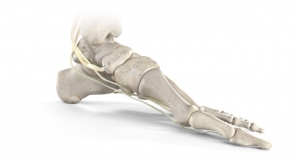Mike Daley, CEO, OrthogenRx02.10.21
Osteoarthritis (OA) is a degenerative disease of the synovial joints, which causes joint pain and functional impairment. It occurs frequently in adults over 50 years old and is a major cause of disability worldwide. OA is a progressive disorder, primarily affecting the cartilage found on the ends of bones in joints, with different degrees of disease severity that requires long-term management.
Over the course of the disease, various options are available to treat the symptoms including non-pharmacologic, pharmacologic, and surgical treatment regimes. In the absence of a cure for OA, there are multiple systemic, oral medications available over-the-counter and by prescription that are commonly used to manage the pain associated with OA. These can include acetaminophen (Tylenol), opioids (Tramadol, Oxycontin, etc.), and non-steroidal anti-inflammatory drugs (NSAIDs; Advil, Aleve, Celebrex, etc.). When administered over a long time for a chronic condition like OA, however, many of these result in significant heart and intestinal toxicity (FDA mandated Black Box Warnings), or addiction issues, especially in patients with other underlying conditions (co-morbidities) that can place these patients at particularly serious risk.
There are also two approved treatments delivered locally by direct injection into the knee joint that can avert many of the drawbacks of the orally administered systemic treatments. These are intra-articular corticosteroid (steroids) and hyaluronic acid (HA) injections. In a recent meta-analysis sponsored by the Agency for Healthcare Research and Quality (AHRQ), an agency of the U.S. Department of Health and Human Services, comparing various treatment options for OA knee pain, intra-articular injections (steroids and HAs) were found to have two to three times greater clinical effect size and less adverse reactions. While steroids generally only require a single injection, their duration of effectiveness (pain relief) is generally limited to four to six weeks. In addition, there is some evidence that frequent and chronic use of steroids may exacerbate the degradative process of cartilage and exacerbate OA disease progression, so their judicious clinical use is recommended.
In contrast, intra-articular HAs require one, three, or five weekly injections, but their clinical benefit tends to last six months or longer, and with minimal side effects. They also have no known drug interactions that could create a clinical concern (OA treatment populations commonly take multiple medications for other conditions). Interestingly, despite this compelling data in favor of intra-articular HA therapy, the American Academy of Orthopedic Surgeons (AAOS) and the American College of Rheumatologists (ACR) have not recommended their use. This is in contrast to most international organizations [Osteoarthritis Research Society International (OARSI), European Society for Clinical and Economic Aspects of Osteoporosis, Osteoarthritis and Musculoskeletal Diseases (ESCEO), and European League Against Rheumatism (EULAR)], which have offered a limited endorsement or fully endorsed the use of intra-articular HAs for the treatment of OA knee pain, especially in patients with multiple comorbidities. Based upon the literature, the negative recommendations are more related to interpretation of the proper negative controls rather than the significant improvement in pain observed in clinical studies.
HA and OA Knee Pain
HA is a glycosaminoglycan, or polymer of a simple disaccharide (N-acetyl-D glucosamine and glucuronic acid) found throughout the body, but in especially high concentrations in the synovial fluid of articular joints, like the knee. As a solution, HA exhibits unique physical properties of viscosity and elasticity (viscoelastic) that assists in joint lubrication, resistance to compression, and shear forces. One of the signs of OA is a decrease in the concentration of HA, as well as a breakdown of the size of the HA polymer (molecular weight). It is believed this change is associated with the elicitation of the clinical symptoms of OA—pain and joint stiffness.
Injection of HA into the joint helps to restore the synovial fluid lubrication and cushioning properties, consequently improving joint biomechanics. A treatment course of intra-articular HA therapy may last for six months or more, and some insurance claims data suggests it may even facilitate long-term benefits, but these observations on HA treatment modifying disease progression require further investigation. In addition, some health insurance claims data suggests HA treatment may reduce the reliance on oral pain medications, including opioids.
Is HA a Device or a Drug?
Both, it would seem, according to the FDA, which is where the problem lies.
Globally, intra-articular injections of HA have been adopted as a common, standard-of-care, non-surgical treatment for OA knee pain. The approved indications are for patients who have failed to respond adequately to conservative nonpharmacologic therapy (e.g., weight loss, exercise, or physical therapy) or over-the-counter analgesics (simple analgesics or NSAIDs). In 1997, the U.S. Food and Drug Administration (FDA), through a formal process called a Request for Designation (RFD), determined that how the product mediated its primary action (i.e., pain relief) was through mechanical means (i.e., lubrication, cushioning, and resistance to shear) as opposed to a substance (other than food) intended to affect the structure or any function of the body. Therefore, HAs were to be regulated as a Class III medical device. Patients treated with intra-articular HA injections who receive six months or more of pain relief may be safely retreated every six months. As previously stated, the HA class has an outstanding safety profile even upon retreatment, with no product-associated deaths recorded and no known interactions with other systemic medications. This safety profile is in strong contrast to many of the standard-of-care oral pain medications often used for OA knee pain. It should be further stated that since the product must be administered by a healthcare professional, there are no issues regarding over-dosing or compliance.
This 33-year global (Japan and Italy, 1987) and 23-year (U.S. FDA, 1997) history of safety and efficacy with a consistent regulatory approval process for HA products was placed in serious jeopardy on December 18, 2018. On that date, without any prior public notice, plan for a staged implementation of the policy, nor clarity in the process, the FDA issued a Notice in the Federal Register (NFR) stating the FDA “believes that intra-articular HA products may be acting as drugs rather than devices.” With a further lack of clarity, they “suggested” companies contemplating a submission “are encouraged to obtain an informal or formal classification and jurisdiction determination”—a request to the Office of Combination Products for a RFD.
Interestingly, dating back to 1993, the Agency has consistently determined on at least five separate occasions that these HA products are Class III medical devices. Although the Notice stated sponsors are merely “encouraged” to obtain jurisdictional review, this NFR has become a de facto policy of the FDA, and subsequently, CDRH will no longer accept pre-market approval (PMA) applications for new HA products that have not undergone such RFD review.
Also, in the two years prior to the NFR, four intra-articular HA products had been submitted and approved, and yet, in the two years following the Notice, not a single intra-articular IAHA product has been approved. The net effect will be less competition and no innovation in products because of this significant and uncertain regulatory pathway. The manufacturers of existing products are also in a quandary because the future status of the 16 IAHA products is unknown. Are they devices or drugs?
Moving forward, even “like products” that are essentially equivalent in composition, dosage form, and formulation will be regulated differently—a clear violation of FDA administrative law. This action was taken without provocation for the safety or effectiveness of the product class. It was taken without new scientific data (FDA references were primarily reviews with primary sources dating back prior to 2005). Furthermore, this new policy regarding intra-articular HA products does not comport with the legal requirement in administrative law—5 U.S.C. § 706 (2)(A)—that like products be treated alike, and the procedures for implementing a policy change without advance notice raises serious concerns over the foundation of device development programs that may not be predictable and could be far reaching. Device or even drug companies will be challenged to find financing to advance their technology in the face of uncertain regulatory pathway.
Consequences of Inconsistent Regulatory Reviews
The underpinnings of device innovation and product development require a clear and predictable approval pathway. This is especially the case for Class III medical devices and drugs or biologics that require randomized controlled clinical studies to obtain regulatory approval and may take a decade to complete at a cost of 100s of millions of dollars. This significant FDA policy change without prior notice may mark a sea-change in the Agency signaling that they plan on future declarations without due process or public hearings for comment, and an ill-defined implementation process. The challenges of investing in healthcare companies is significant and no investor will find such uncertainty an acceptable level of risk for a financial commitment thus putting at jeopardy the very fuel that drives the biopharmaceutical/medical technology engine of innovation.
This action by the FDA begs the question, “What’s next?” Will they reconsider decisions on absorbable biomaterials, stents, devices that require integration with surrounding tissues, drugs or biologics that may exhibit unique physical properties? This misguided lack of adherence to established processes must stop, and the Agency needs to reflect and implement judicious and well-planned processes as defined by the law to govern product oversight before they effectively disrupt the device and some segments of the drug innovation pipeline.
Over the course of the disease, various options are available to treat the symptoms including non-pharmacologic, pharmacologic, and surgical treatment regimes. In the absence of a cure for OA, there are multiple systemic, oral medications available over-the-counter and by prescription that are commonly used to manage the pain associated with OA. These can include acetaminophen (Tylenol), opioids (Tramadol, Oxycontin, etc.), and non-steroidal anti-inflammatory drugs (NSAIDs; Advil, Aleve, Celebrex, etc.). When administered over a long time for a chronic condition like OA, however, many of these result in significant heart and intestinal toxicity (FDA mandated Black Box Warnings), or addiction issues, especially in patients with other underlying conditions (co-morbidities) that can place these patients at particularly serious risk.
There are also two approved treatments delivered locally by direct injection into the knee joint that can avert many of the drawbacks of the orally administered systemic treatments. These are intra-articular corticosteroid (steroids) and hyaluronic acid (HA) injections. In a recent meta-analysis sponsored by the Agency for Healthcare Research and Quality (AHRQ), an agency of the U.S. Department of Health and Human Services, comparing various treatment options for OA knee pain, intra-articular injections (steroids and HAs) were found to have two to three times greater clinical effect size and less adverse reactions. While steroids generally only require a single injection, their duration of effectiveness (pain relief) is generally limited to four to six weeks. In addition, there is some evidence that frequent and chronic use of steroids may exacerbate the degradative process of cartilage and exacerbate OA disease progression, so their judicious clinical use is recommended.
In contrast, intra-articular HAs require one, three, or five weekly injections, but their clinical benefit tends to last six months or longer, and with minimal side effects. They also have no known drug interactions that could create a clinical concern (OA treatment populations commonly take multiple medications for other conditions). Interestingly, despite this compelling data in favor of intra-articular HA therapy, the American Academy of Orthopedic Surgeons (AAOS) and the American College of Rheumatologists (ACR) have not recommended their use. This is in contrast to most international organizations [Osteoarthritis Research Society International (OARSI), European Society for Clinical and Economic Aspects of Osteoporosis, Osteoarthritis and Musculoskeletal Diseases (ESCEO), and European League Against Rheumatism (EULAR)], which have offered a limited endorsement or fully endorsed the use of intra-articular HAs for the treatment of OA knee pain, especially in patients with multiple comorbidities. Based upon the literature, the negative recommendations are more related to interpretation of the proper negative controls rather than the significant improvement in pain observed in clinical studies.
HA and OA Knee Pain
HA is a glycosaminoglycan, or polymer of a simple disaccharide (N-acetyl-D glucosamine and glucuronic acid) found throughout the body, but in especially high concentrations in the synovial fluid of articular joints, like the knee. As a solution, HA exhibits unique physical properties of viscosity and elasticity (viscoelastic) that assists in joint lubrication, resistance to compression, and shear forces. One of the signs of OA is a decrease in the concentration of HA, as well as a breakdown of the size of the HA polymer (molecular weight). It is believed this change is associated with the elicitation of the clinical symptoms of OA—pain and joint stiffness.
Injection of HA into the joint helps to restore the synovial fluid lubrication and cushioning properties, consequently improving joint biomechanics. A treatment course of intra-articular HA therapy may last for six months or more, and some insurance claims data suggests it may even facilitate long-term benefits, but these observations on HA treatment modifying disease progression require further investigation. In addition, some health insurance claims data suggests HA treatment may reduce the reliance on oral pain medications, including opioids.
Is HA a Device or a Drug?
Both, it would seem, according to the FDA, which is where the problem lies.
Globally, intra-articular injections of HA have been adopted as a common, standard-of-care, non-surgical treatment for OA knee pain. The approved indications are for patients who have failed to respond adequately to conservative nonpharmacologic therapy (e.g., weight loss, exercise, or physical therapy) or over-the-counter analgesics (simple analgesics or NSAIDs). In 1997, the U.S. Food and Drug Administration (FDA), through a formal process called a Request for Designation (RFD), determined that how the product mediated its primary action (i.e., pain relief) was through mechanical means (i.e., lubrication, cushioning, and resistance to shear) as opposed to a substance (other than food) intended to affect the structure or any function of the body. Therefore, HAs were to be regulated as a Class III medical device. Patients treated with intra-articular HA injections who receive six months or more of pain relief may be safely retreated every six months. As previously stated, the HA class has an outstanding safety profile even upon retreatment, with no product-associated deaths recorded and no known interactions with other systemic medications. This safety profile is in strong contrast to many of the standard-of-care oral pain medications often used for OA knee pain. It should be further stated that since the product must be administered by a healthcare professional, there are no issues regarding over-dosing or compliance.
This 33-year global (Japan and Italy, 1987) and 23-year (U.S. FDA, 1997) history of safety and efficacy with a consistent regulatory approval process for HA products was placed in serious jeopardy on December 18, 2018. On that date, without any prior public notice, plan for a staged implementation of the policy, nor clarity in the process, the FDA issued a Notice in the Federal Register (NFR) stating the FDA “believes that intra-articular HA products may be acting as drugs rather than devices.” With a further lack of clarity, they “suggested” companies contemplating a submission “are encouraged to obtain an informal or formal classification and jurisdiction determination”—a request to the Office of Combination Products for a RFD.
Interestingly, dating back to 1993, the Agency has consistently determined on at least five separate occasions that these HA products are Class III medical devices. Although the Notice stated sponsors are merely “encouraged” to obtain jurisdictional review, this NFR has become a de facto policy of the FDA, and subsequently, CDRH will no longer accept pre-market approval (PMA) applications for new HA products that have not undergone such RFD review.
Also, in the two years prior to the NFR, four intra-articular HA products had been submitted and approved, and yet, in the two years following the Notice, not a single intra-articular IAHA product has been approved. The net effect will be less competition and no innovation in products because of this significant and uncertain regulatory pathway. The manufacturers of existing products are also in a quandary because the future status of the 16 IAHA products is unknown. Are they devices or drugs?
Moving forward, even “like products” that are essentially equivalent in composition, dosage form, and formulation will be regulated differently—a clear violation of FDA administrative law. This action was taken without provocation for the safety or effectiveness of the product class. It was taken without new scientific data (FDA references were primarily reviews with primary sources dating back prior to 2005). Furthermore, this new policy regarding intra-articular HA products does not comport with the legal requirement in administrative law—5 U.S.C. § 706 (2)(A)—that like products be treated alike, and the procedures for implementing a policy change without advance notice raises serious concerns over the foundation of device development programs that may not be predictable and could be far reaching. Device or even drug companies will be challenged to find financing to advance their technology in the face of uncertain regulatory pathway.
Consequences of Inconsistent Regulatory Reviews
The underpinnings of device innovation and product development require a clear and predictable approval pathway. This is especially the case for Class III medical devices and drugs or biologics that require randomized controlled clinical studies to obtain regulatory approval and may take a decade to complete at a cost of 100s of millions of dollars. This significant FDA policy change without prior notice may mark a sea-change in the Agency signaling that they plan on future declarations without due process or public hearings for comment, and an ill-defined implementation process. The challenges of investing in healthcare companies is significant and no investor will find such uncertainty an acceptable level of risk for a financial commitment thus putting at jeopardy the very fuel that drives the biopharmaceutical/medical technology engine of innovation.
This action by the FDA begs the question, “What’s next?” Will they reconsider decisions on absorbable biomaterials, stents, devices that require integration with surrounding tissues, drugs or biologics that may exhibit unique physical properties? This misguided lack of adherence to established processes must stop, and the Agency needs to reflect and implement judicious and well-planned processes as defined by the law to govern product oversight before they effectively disrupt the device and some segments of the drug innovation pipeline.




























